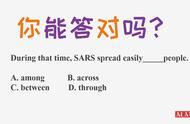翻译SCI论文对于英语水平不好的人来说,真是一件十分头疼的问题,要达到母语化的翻译水平,只能靠平时的积累或是找专业的翻译编辑帮忙。本次将介绍常用的且易混淆的介词和介词短语的用法,以供大家参考。
在论文中,常用的主要介词如 about、above、by、for、from、in、on、to、with 等和复合介词如 apart from、away from、because of、instead of、out of、regardless of、due to、owing to 等。
介词短语主要有以下几种组合形式:名词 介词,如:access to、appeal to、delight in,形容词 介词,如 aware of、good at、interested in、similar to,介词 名词( 介词),如 out of turn、on demand、in proportion to 等为了对比学习,本节主要介绍几组介词及其用法以及应用中的相关注意事项。
(1)at、on、in 表示时间意义的用法区别。at 表示时间的一个点,on 表示具斯的某一天,in 表示在某年、某月。如 at eight o'clock,on October 1,1949,on Sundays,in1949,in last June
(2)at、on、in 表示位置意义的用法区别。at 表示在某一点,on 表示在线和面上,in 表示某一范围大些的地点。
例:
① The substitution takes place at the position of α-carbon atom.
② A thin film was formed on the surface of the plate.
③ The DEAE-Sephacel was eluted with 10 column volumes of a 0—200mmol/L NaCl gradient in the Tris buffer.
另外表示速度用 at。
例:The car ran at a speed of 120 miles per hour.
(3)among 和 between 用法上的区别。两者都是表示“之间”、“中间”的意,但用法上有区别,前者用于三者以上,后者用于“两者之间”。
例:
① Among all the metals,iron is the most widely used in the daily life.
② What is the difference between a mixture and a compound?
当 between 用于“三者以上”,则表示其中每两者之间的相互关系。
例:
Early man did not know how to explain the differece betweengases , solids and liquids.
(4)当 by、with、through 表示“工具”和“手段”时三者才可以互换。
例:
① He crossed the stream by a little bridge.
② They measured the temperature with a new-type instrument.
③ I learnt of the position through a newspaper advertisement.
(5)by、during、till 和 until 表示时间上的用法区别。By 表示时间点,不与延续性动词连用,during 表示一段持续时间,till 和 until 在肯定句只与延续性动词连用。
广告中国人,中国梦(德)
作者:《中国人,中国梦》编写组
京东
例:
① You must be back by four o'clock
② The sun gives us light during the day.
③ They work from 6 o'clock in the morning till(until)2 o'clock in the afternoon.
(6)for、from、through、with、out of、because of、on account of 等介词表示原因,动机或理由。其中 for 和 out of 主要表达动机。
例:
① The insulant was burned for overheating.
② He has done it from a sense of duty.
③ We lost ourselves through not knowing the way.
④ With such knowledge and experience,he is sure to succeed.
⑤ The method is quoted out of the literature.
⑥ The compound was prepared out of necessity.
⑦ Alloys are important because of their usefulness in industry.
③ The solution became cloudiness on account of the precipitate formed.
(7)owing to 和 due to 的用法区别。两者都是介词,但 owing to 是副词性复合介词,可作状语,而 due to 是形容词性复合介词,只能作表语。
例:
① Owing to his careless driving,we had a bad accident.
② The accident was due to careless driving.
(8)except、except for、but、apart from 等都表示“除……之外”的含义,但在用法上有细节上的差异。其中 except for 后面的所指可与前面所云可非同类,且有美中不足之义,but 不能用于句首,只能用在 no、any、every 等构成的合成词以及 all、none 等词之后,apart from 类似于 besides 和 except for。
例:
① All atoms except those of hydrogen,contain one or more neutrons in the nuclei.
② This machine is of a new type except for a few shortcomings here and there.
③ They chose none but the best.
④ None but strong acids are suitable for the reaction.
实际上在英语科技论文的撰写过程中,介词的使用既是重点又是难点,因为很多介词都有基本用法,又有许多例外情况,这里介绍的也只是常用介词中有限的几个。真正要掌握好介词的用法除了要熟悉它们的基本用法外,更要牢记它们的固定搭配,只有这样方能自如地、准确地使用介词。本次分享就到此结束,想了解更多SCI科研论文方面的资讯请关注我们。















